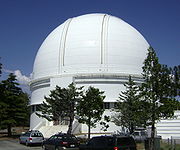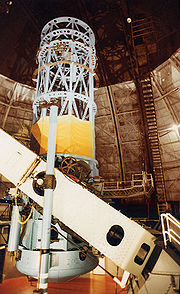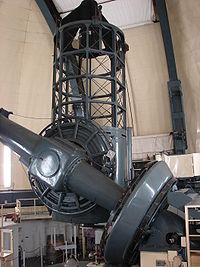
C. Donald Shane telescope
Encyclopedia
The C. Donald Shane telescope is a 120 inches (3 m) reflecting telescope
located at the Lick Observatory
in California
. It was named after astronomer C. Donald Shane
in 1978, who led the effort to acquire the necessary funds from the California Legislature
, and who then oversaw the telescope's construction. It is the largest and most powerful telescope at the Lick Observatory, and was the 2nd largest telescope in the world when it was commissioned in 1959.
The Shane's mirror started as a 10,000 lb Corning Labs glass test blank for the Palomar Observatory
's 200 inch (5 m) Hale telescope
(in southern California), but was sold below cost ($50,000 USD) by CalTech to the Lick Observatory. It was then transported to Mount Hamilton where the blank was ground and polished by the Observatory.
, or the intermediate cassegrain
focus.
In the Shane dome there is a laser
, whose light is sometimes visible with the naked eye, that the observatory beams from the Shane telescope into the night sky. The laser is part of the Lick Adaptive Optics (LAO) program, a joint project of the Lick Observatory and the Lawrence Livermore National Laboratory
. LAO corrects for atmospheric turbulence either by using a natural guide star
or by creating a sodium laser guide star
, and using the observed motion of the guide star to direct distortion of a deformable mirror hundreds of times each second. The system produces images that are nearly equivalent to those obtained from space-based telescopes. Adaptive optics
using natural guide stars has been in development since 1996, and using laser guide stars since 2001. Similar laser adaptive optics systems based on LAO have been installed on the University of California
's two Keck telescopes
in Hawaii
.
 For Lick Obsevatory's first 55 years of operation, its astronomer
For Lick Obsevatory's first 55 years of operation, its astronomer
s relied on two telescopes built in the 19th century. Once considered giants in the field, they had become obsolete. International competition was mounting. The 120 inch reflector addition took 15 years to complete, being completed in 1959. It would be the second largest telescope in the World, taking its place behind the then enormous 200 inch Palomar Hale Telescope
.
Reflecting telescope
A reflecting telescope is an optical telescope which uses a single or combination of curved mirrors that reflect light and form an image. The reflecting telescope was invented in the 17th century as an alternative to the refracting telescope which, at that time, was a design that suffered from...
located at the Lick Observatory
Lick Observatory
The Lick Observatory is an astronomical observatory, owned and operated by the University of California. It is situated on the summit of Mount Hamilton, in the Diablo Range just east of San Jose, California, USA...
in California
California
California is a state located on the West Coast of the United States. It is by far the most populous U.S. state, and the third-largest by land area...
. It was named after astronomer C. Donald Shane
C. Donald Shane
Charles Donald Shane was an American astronomer and director of the Lick Observatory of the University of California from 1945 to 1958, during which time he carried out his monumental program of counting external galaxies and investigating their distribution.In 1920, Shane received his doctorate...
in 1978, who led the effort to acquire the necessary funds from the California Legislature
California State Legislature
The California State Legislature is the state legislature of the U.S. state of California. It is a bicameral body consisting of the lower house, the California State Assembly, with 80 members, and the upper house, the California State Senate, with 40 members...
, and who then oversaw the telescope's construction. It is the largest and most powerful telescope at the Lick Observatory, and was the 2nd largest telescope in the world when it was commissioned in 1959.
The Shane's mirror started as a 10,000 lb Corning Labs glass test blank for the Palomar Observatory
Palomar Observatory
Palomar Observatory is a privately owned observatory located in San Diego County, California, southeast of Pasadena's Mount Wilson Observatory, in the Palomar Mountain Range. At approximately elevation, it is owned and operated by the California Institute of Technology...
's 200 inch (5 m) Hale telescope
Hale telescope
The Hale Telescope is a , 3.3 reflecting telescope at the Palomar Observatory in California, named after astronomer George Ellery Hale. With funding from the Rockefeller Foundation, he orchestrated the planning, design, and construction of the observatory, but did not live to see its commissioning...
(in southern California), but was sold below cost ($50,000 USD) by CalTech to the Lick Observatory. It was then transported to Mount Hamilton where the blank was ground and polished by the Observatory.
Features
The Shane telescope is really three telescopes in one. It can be used in wide field prime focus, coudé focus for high precision spectroscopySpectroscopy
Spectroscopy is the study of the interaction between matter and radiated energy. Historically, spectroscopy originated through the study of visible light dispersed according to its wavelength, e.g., by a prism. Later the concept was expanded greatly to comprise any interaction with radiative...
, or the intermediate cassegrain
Cassegrain reflector
The Cassegrain reflector is a combination of a primary concave mirror and a secondary convex mirror, often used in optical telescopes and radio antennas....
focus.
In the Shane dome there is a laser
Laser
A laser is a device that emits light through a process of optical amplification based on the stimulated emission of photons. The term "laser" originated as an acronym for Light Amplification by Stimulated Emission of Radiation...
, whose light is sometimes visible with the naked eye, that the observatory beams from the Shane telescope into the night sky. The laser is part of the Lick Adaptive Optics (LAO) program, a joint project of the Lick Observatory and the Lawrence Livermore National Laboratory
Lawrence Livermore National Laboratory
The Lawrence Livermore National Laboratory , just outside Livermore, California, is a Federally Funded Research and Development Center founded by the University of California in 1952...
. LAO corrects for atmospheric turbulence either by using a natural guide star
Guide star
In astronomy, a guide star is a reference star used to accurately maintain the tracking by a telescope of a heavenly body, whose motion across the sky is primarily due to the rotation of the Earth....
or by creating a sodium laser guide star
Laser guide star
Laser guide stars are a form of artificial star created for use in astronomical adaptive optics imaging.Adaptive optics systems require a wavefront reference source in order to correct atmospheric distortion of light...
, and using the observed motion of the guide star to direct distortion of a deformable mirror hundreds of times each second. The system produces images that are nearly equivalent to those obtained from space-based telescopes. Adaptive optics
Adaptive optics
Adaptive optics is a technology used to improve the performance of optical systems by reducing the effect of wavefront distortions. It is used in astronomical telescopes and laser communication systems to remove the effects of atmospheric distortion, and in retinal imaging systems to reduce the...
using natural guide stars has been in development since 1996, and using laser guide stars since 2001. Similar laser adaptive optics systems based on LAO have been installed on the University of California
University of California
The University of California is a public university system in the U.S. state of California. Under the California Master Plan for Higher Education, the University of California is a part of the state's three-tier public higher education system, which also includes the California State University...
's two Keck telescopes
Keck telescopes
The W. M. Keck Observatory is a two-telescope astronomical observatory at an elevation of near the summit of Mauna Kea in Hawai'i. The primary mirrors of each of the two telescopes are in diameter, making them the second largest optical telescopes in the world, slightly behind the Gran Telescopio...
in Hawaii
Hawaii
Hawaii is the newest of the 50 U.S. states , and is the only U.S. state made up entirely of islands. It is the northernmost island group in Polynesia, occupying most of an archipelago in the central Pacific Ocean, southwest of the continental United States, southeast of Japan, and northeast of...
.
History

Astronomer
An astronomer is a scientist who studies celestial bodies such as planets, stars and galaxies.Historically, astronomy was more concerned with the classification and description of phenomena in the sky, while astrophysics attempted to explain these phenomena and the differences between them using...
s relied on two telescopes built in the 19th century. Once considered giants in the field, they had become obsolete. International competition was mounting. The 120 inch reflector addition took 15 years to complete, being completed in 1959. It would be the second largest telescope in the World, taking its place behind the then enormous 200 inch Palomar Hale Telescope
Hale telescope
The Hale Telescope is a , 3.3 reflecting telescope at the Palomar Observatory in California, named after astronomer George Ellery Hale. With funding from the Rockefeller Foundation, he orchestrated the planning, design, and construction of the observatory, but did not live to see its commissioning...
.
Contemporaries on commissioning
The Shane telescope saw first light to a different world for large telescopes in 1959:| # | Name / Observatory |
Image | Aperture | Altitude | First Light |
Special advocate |
|---|---|---|---|---|---|---|
| 1 | Hale Telescope Hale telescope The Hale Telescope is a , 3.3 reflecting telescope at the Palomar Observatory in California, named after astronomer George Ellery Hale. With funding from the Rockefeller Foundation, he orchestrated the planning, design, and construction of the observatory, but did not live to see its commissioning... Palomar Obs. Palomar Observatory Palomar Observatory is a privately owned observatory located in San Diego County, California, southeast of Pasadena's Mount Wilson Observatory, in the Palomar Mountain Range. At approximately elevation, it is owned and operated by the California Institute of Technology... |
 |
200 inch 508 cm |
1713 m (5620 ft) |
1948 | George Ellery Hale George Ellery Hale George Ellery Hale was an American solar astronomer.-Biography:Hale was born in Chicago, Illinois. He was educated at MIT, at the Observatory of Harvard College, , and at Berlin . As an undergraduate at MIT, he is known for inventing the spectroheliograph, with which he made his discovery of... John D. Rockefeller John D. Rockefeller John Davison Rockefeller was an American oil industrialist, investor, and philanthropist. He was the founder of the Standard Oil Company, which dominated the oil industry and was the first great U.S. business trust. Rockefeller revolutionized the petroleum industry and defined the structure of... |
| 2 | Shane Telescope Lick Observatory |
 |
120 inch 305 cm |
1283 m (4209 ft) |
1959 | Nicholas Mayall Nicholas Mayall Nicholas Ulrich Mayall was an American observational astronomer. After obtaining his doctorate from the University of California, Berkeley, Mayall worked at the Lick Observatory, where he remained from 1934–1960, except for a brief period at MIT's Radiation Laboratory during World War II.During... C. Donald Shane |
| 3 | Hooker Telescope Mount Wilson Obs. Mount Wilson Observatory The Mount Wilson Observatory is an astronomical observatory in Los Angeles County, California, United States. The MWO is located on Mount Wilson, a 5,715 foot peak in the San Gabriel Mountains near Pasadena, northeast of Los Angeles... |
 |
100 inch 254 cm |
1742 m (5715 ft) |
1917 | George Ellery Hale George Ellery Hale George Ellery Hale was an American solar astronomer.-Biography:Hale was born in Chicago, Illinois. He was educated at MIT, at the Observatory of Harvard College, , and at Berlin . As an undergraduate at MIT, he is known for inventing the spectroheliograph, with which he made his discovery of... Andrew Carnegie Andrew Carnegie Andrew Carnegie was a Scottish-American industrialist, businessman, and entrepreneur who led the enormous expansion of the American steel industry in the late 19th century... |
| 4 | Otto Struve Telescope Otto Struve Telescope The Otto Struve Telescope was the first major telescope to be built at McDonald Observatory. Located in the Davis Mountains in West Texas, the Otto Struve Telescope was designed by Warner & Swasey Company and constructed between 1933 and 1939 by the Paterson-Leitch Company. Its 2.1 meter mirror... McDonald Obs. McDonald Observatory The McDonald Observatory is an astronomical observatory located near the unincorporated community of Fort Davis in Jeff Davis County, Texas, United States. The facility is located on Mount Fowlkes and Mount Locke in the Davis Mountains of West Texas... |
 |
82 inch 210 cm |
2,070 m 6791 ft |
1939 | Otto Struve Otto Struve Otto Struve was a Russian astronomer. In Russian, his name is sometimes given as Otto Lyudvigovich Struve ; however, he spent most of his life and his entire scientific career in the United States... |

